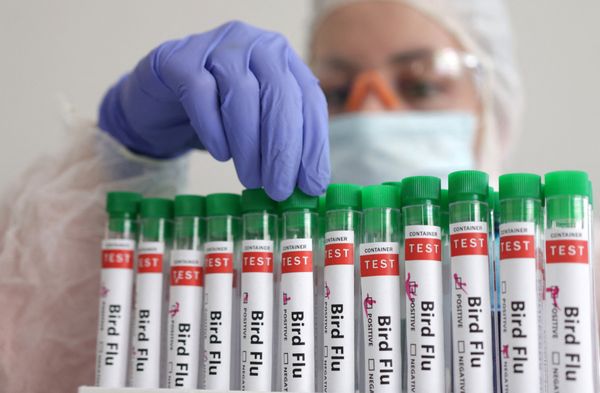
By now, the spaceship should have been on its way to the moon. By now, NASA had hoped, the gumdrop-shaped capsule—designed to carry astronauts someday—would be sending all kinds of data back home, showing engineers how its first journey to space was going.
But the capsule is still here, sitting atop a giant rocket that has so far refused to leave Earth. NASA spent weeks hyping up the inaugural flight of the Space Launch System, the rocket at the center of America’s ambitious effort to land astronauts on the moon again in this decade. Celebrity appearances and musical performances were lined up. There were enough Krispy Kreme doughnuts at the Kennedy Space Center to feed the whole state of Florida. Even the vice president flew in. And yet, the rocket has stayed put.
Plenty of natural factors can lead to a launch delay: nearby lightning, hovering cumulus clouds, the rotation of the planet itself. But in the case of the Space Launch System, the problems were with the rocket. NASA postponed its first attempt, at the end of August, after a sensor indicated an issue with one of the main engines. The agency called off its second attempt this weekend after the liquid-hydrogen tank sprouted a leak too big for engineers to contain. NASA will have a chance to make a third attempt in late September or October, after engineers have pulled the rocket off the launchpad and back indoors to inspect the system and reset its batteries. “We’re not going to launch until it’s right,” Bill Nelson, the NASA administrator, told reporters this weekend. The moon will have to wait a bit longer.
Folks in the rocket business weren’t surprised that the Space Launch System didn’t take off on its first, or even second, attempt. Delays happen, and so do leaks; the Space Launch System is a new vehicle made partially out of old, familiar parts from NASA’s now-retired fleet of space shuttles, which experienced their own frustrating share of escaping hydrogen. But two scrapped attempts in one week is a disappointing setback for the country’s new moon program, named Artemis (for Apollo’s sister in Greek mythology).
[Read: America is trying to make the moon happen again]
The rocket program is already years behind schedule and many taxpayers’ dollars over budget. NASA no longer faces a geopolitical space race, but it does have to contend with competition at home from private rocket manufacturers that have vowed to fly more often and at a lower cost than the government. A series of delays could bolster the argument that maybe NASA, the only organization to ever put human beings on the lunar surface, shouldn’t be in the business of launching moon rockets at all. The successful operation of the Space Launch System is as much about going back to the moon as it is about demonstrating that NASA’s approach is worth it.
The first Artemis mission involves the Space Launch System lofting the astronaut capsule, called Orion, on a weeks-long trek around the moon and back. It’s a technical demonstration, a test of countless parts and components to make sure the vehicle is safe for people. If Orion performs as designed, survives the blazing reentry through Earth’s atmosphere, and ends up back in the hands of engineers, NASA will move on to the next stage of the program: another test-drive around the moon, this time with a crew of four astronauts. If that goes well, the next mission will culminate in a landing on the surface.
Humankind has done this kind of thing before. From 1969 to 1972, NASA put men on the moon six times, using technology with less computing power than the little devices that manage our 21st-century lives. The astronauts descended to the surface and explored, ate, and slept while the rest of humanity chugged along nearly 240,000 miles away. This time, NASA wants to do things a little differently. The next crew to set foot on the dusty regolith, for example, will not be solely composed of white men; NASA has promised that the group will include the first woman and the first person of color on the moon. And the landings are meant to bring about a sustained presence on the moon, a future with habitats and rovers on the surface and a small space station circling overhead.
At the Kennedy Space Center, along the country’s “Space Coast,” people were buzzing with anticipation in the days before both Artemis 1 attempts. Astronauts dressed in blue jumpsuits milled around, sneaking glances at the rocket that could someday be their ride. When I asked Victor Glover, a NASA astronaut who might very well be part of the first crew to land, which Artemis trip he’d want to take, he said, “I don't know, but if they want me on a mission, I’ll be ready when my time comes.”
[Read: Why is NASA’s hold music so catchy?]
A rocket built for the moon hasn’t flown since 1972. After the crew of Apollo 17 returned, the American space program, subject to political whims and budget fluctuations, turned closer to home. NASA built space shuttles, and astronauts rode them into orbit and helped assemble the International Space Station. The development of the Space Launch System got under way in 2010, and, fueled by bipartisan support and liquid hydrogen, the effort managed to survive several presidential administrations and reach the launchpad this year, bringing the country closer to a moon return than it has been in recent memory.
All that history, though, might be slowing NASA down. The Space Launch System design relies on hardware that was used in NASA’s shuttles, which were retired in 2011 after 30 years of operations. The rocket’s fuel includes liquid hydrogen, which, although more efficient, is also more prone to leaks than the methane that other rocket manufacturers have begun to use. And after every launch, NASA’s rocket must ditch some very expensive hardware into the ocean, with no hope of reusing any of it—something that commercial companies have demonstrated they can do.
One of those commercial companies, SpaceX, is developing its own moon rocket, known as Starship. A decade ago, the public might have scoffed at the idea of Elon Musk’s rowdy start-up doing anything very historic. But today, SpaceX is NASA’s only ride to the International Space Station, and the agency has signed with the company to launch several of its upcoming missions, including a new space telescope and a probe to study one of Jupiter’s icy moons. Not only that, NASA has also hired SpaceX to produce the lander that future Artemis astronauts will use to ride down to the moon’s surface, plus the spacecraft that will help nudge it toward lunar orbit. In a future where SpaceX technology could do all that, the government rocket might seem almost superfluous. Of course, like NASA’s rocket, Starship will likely face its own issues. But if a Starship explodes, Congress isn’t going to haul in SpaceX officials and demand a formal explanation. The private company can keep going in a way that a federal space agency can't.
[Read: Someone show NASA a calendar]
NASA has set some very ambitious timelines for the Artemis program, and each one should be taken with a grain of moon dust—especially the working target for the first landing, in 2025. The landing technology from SpaceX is still in the works. The spacesuits have yet to be completed. Even the toilet that will eventually be installed in the Orion capsule—don’t laugh; it’s a crucial piece of technology!—is still being tested on the International Space Station, and according to a NASA engineering manager, it’s running into some problems. NASA budgets haven’t begun to account for the habitats and rovers that astronauts would use after they’ve perfected landing on the surface. America could certainly put astronauts on the moon before this decade is out, but we’re a long way from lunar glamping.
This early in the Artemis story, high-profile delays raise all sorts of questions that NASA would rather not answer, ranging from What’s taking so long to get back there? to Why are we even going at all? The American space program has always received mixed reviews. NASA doesn’t talk about it now, but many Americans didn’t support the Apollo program, which unfolded during the late 1960s—a chaotic and painful era in the country’s history. The United States had enough work to do here on this planet without pouring money into leaving it, people argued. Mark Kirasich, the NASA deputy associate administrator in charge of outlining the Artemis program, was 9 years old when Neil Armstrong and Buzz Aldrin walked on the moon, and he remembers thinking that, after a feat like that, people would soon travel even deeper into space. In fact, NASA officials envisioned that, after the moon feat, astronauts could reach Mars by the early 1980s. “When you looked at my coloring book, it had all kinds of space vehicles going all over the universe,” Kirasich told me.
This time around, NASA’s budget is much smaller, and the agency is selling the public on several reasons for going back to the moon: scientific exploration, economic opportunities, inspiring a new generation. At the Kennedy Space Center, the wrapper of a special launch treat—an Artemis-branded chocolate-covered, marshmallow-topped biscuit—declared that the launch was “for the benefit of all humanity.” The unofficial slogan for Artemis 1—“We are going”—is, in a way, perfect. It offers no immediate explanation; it is free of justification.
Whatever the rationale, a triumphant return to the moon can only begin in one place: on the launchpad, with a successful liftoff of a rocket. NASA must now wait for technicians to complete various repairs, including replacing a seal that would prevent liquid hydrogen from flitting out. Hydrogen is the smallest molecule in the universe, which makes it difficult to contain, even with the best materials on the market, Jim Free, NASA’s associate administrator for exploration-systems development, told me this weekend. Free joined NASA in 1990, when the agency spent months trying to find the source of a hydrogen leak in one of the space shuttles. They couldn’t get off the ground without resolving it. When I asked Free whether he thinks that the Space Launch System could face its own frustrating season—that a tiny molecule could stall the nation’s attempt to reach the moon this year—he gave a nervous laugh. “I hope not,” he said.







